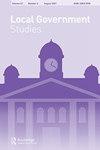国内人口向小城市迁移的决定因素:当地公共产品、就业机会和生命周期阶段
IF 1.9
4区 管理学
Q2 POLITICAL SCIENCE
引用次数: 0
摘要
人们从小城市搬到大城市往往是为了寻找更好的经济机会。但是,是什么促使人们从大城市迁移到公认的就业机会和前景都更少的小城市呢?在韩国的背景下,本研究的实证结果显示,个人移居较小规模的二线城市的意愿与当地公共产品的感知呈正相关,但令人惊讶的是,与就业机会并没有显著相关。然而,这种评价因婚姻状况和家庭生命周期阶段而异。此外,我们的研究结果说明了非就业因素的重要性:对当前居住和地方联系的不满(例如,以前居住的时间长短和心理上的地方依恋)是促使国内人口向较小的二级城市迁移的强烈因素。我们讨论了这些发现对旨在吸引新的青壮年成年居民的小城市的地方政府和政策制定者的影响。关键词:内部迁移居民流动地方公益地方政府披露声明作者未报告潜在利益冲突。本研究由翰林大学研究基金资助,2021 (HRF-20211-008)。本文章由计算机程序翻译,如有差异,请以英文原文为准。
Determinants of internal migration to smaller cities: local public goods, job opportunities, and lifecycle stages
ABSTRACTPeople moving from smaller to larger cities often do so in search of better economic opportunities. But what motivates migration from larger to smaller cities, which are acknowledged to offer fewer available jobs and prospects? This study’s empirical findings, in the context of South Korea, reveal that an individual’s willingness to move to a smaller-sized, secondary city is positively associated with the perception of local public goods there, but, surprisingly, not significantly aligned with job opportunities. However, this valuation differs by marital status and family-life-cycle stage. In addition, our results illustrate the importance of non-employment factors: dissatisfaction with current residency and place ties (e.g., length of previous residence and psychological place attachment) are strong factors motivating internal migration intention to smaller secondary cities. We discuss the implications of these findings for local government and policy makers in small cities that aim to attract new young and middle-aged adult residents.KEYWORDS: Internal migrationResidential mobilityLocal public goodPlace attachmentLocal government Disclosure statementNo potential conflict of interest was reported by the author(s).Notes1. https://www.pewresearch.org/social-trends/2021/12/16/americans-are-less-likely-than-before-covid-19-to-want-to-live-in-cities-more-likely-to-prefer-suburbs/#fn-31709–1Additional informationFundingThis work was supported by the Hallym University Research Fund, 2021 (HRF-20211-008).
求助全文
通过发布文献求助,成功后即可免费获取论文全文。
去求助
来源期刊

Local Government Studies
Multiple-
CiteScore
4.80
自引率
15.80%
发文量
43
期刊介绍:
Local Government Studies is the leading journal for the study of local politics, policy, public administration and management and governance. First established in 1975, it is an influential forum for critical dialogue and exchange on local government and a vital resource for academics, politicians, policy makers and practitioners internationally. The editors welcome submissions in this field, particularly work of a comparative, methodologically innovative and theoretically challenging nature.
 求助内容:
求助内容: 应助结果提醒方式:
应助结果提醒方式:


